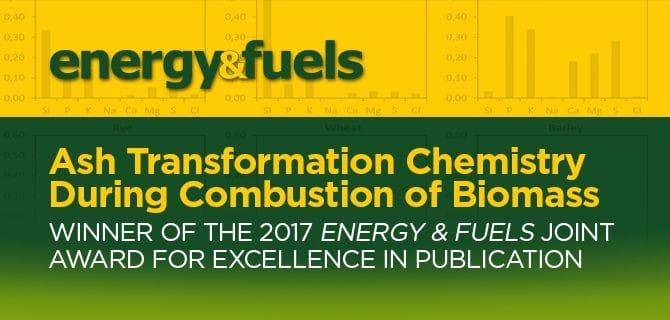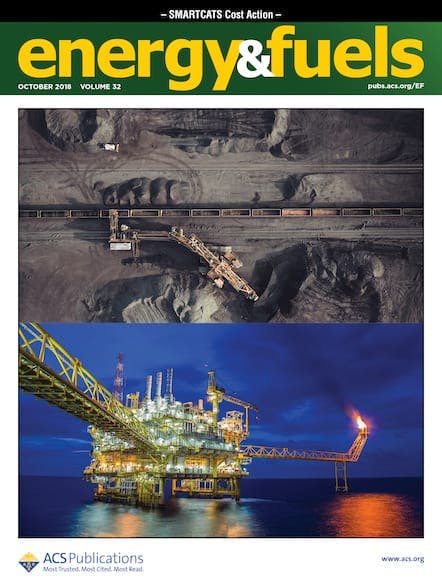This annual award honors an outstanding article published in the journal within the past five years.

The article “Ash Transformation Chemistry during Combustion of Biomass” by Dan Boström, Nils Skoglund, Alejandro Grimm, Christoffer Boman, Marcus Öhman, Markus Broström, and Rainer Backman is the winner of the 2017 Energy & Fuels Joint Award for Excellence in Publication. Energy & Fuels and the ACS Division of Energy & Fuels sponsor this annual award, which honors an outstanding article published in the journal within the past five years.
“This is a milestone paper on the fundamental ash chemistry related to ash transformation reactions during combustion of woody biomass,” says Energy & Fuels Editor-in-Chief Mike Klein. “The paper provides a useful and concise conceptual model for guiding the understanding the behavior of ash matter during thermochemical processing and utilization of any biomass fuel.”
As the corresponding author of the paper recognized by the 2017 Energy & Fuels Joint Award for Excellence in Publication, Dan Boström will present at an ACS Division of Energy & Fuels session in honor of the paper at the 2017 ACS Fall National Meeting in Washington, D.C. Energy & Fuels and the Division encourage you to attend the session. Check the ENFL program for the Fall National Meeting later this summer to get more details!
An Interview with the Winning Authors
I recently connected with the paper’s authors to learn more about their award-winning work and what they’ve done since. Here are the highlights of our conversation.
What follow-up research have you and/or your co-authors done since publishing this award-winning paper?
The award-winning paper represented an attempt, at that time (2012), to compile and create a comprehensive summary of our work in the field of ash transformation during conversion of biomass in terms of a generalized conceptual model. We have since used the model as a foundation for other research on a variety of topics and also attempted to refine it further.
As pointed out in the paper, we were – and still are – well aware of the lack of fundamental data which are crucial for the model in several respects and we have made efforts to remedy these knowledge gaps. Additionally, the paper describes a concept with a schematic model for reactivity where there exists a need for more detailed studies regarding reaction rates during conversion of biomass.
To mention some of the research performed recently, we have published several studies that have utilized the suggested model to predict suitable blend ratios in co-combustion of various biomasses and waste streams. This has proven a highly suitable approach that sidesteps several of the issues inherent in methods like simple fuel indices, because it takes all main ash-forming elements into consideration rather than simply focus on a couple of molar ratios.
The model has been useful for expanding the knowledge regarding the role of phosphates and silicates and the ash transformation reactions have been further defined to include primary, secondary, and tertiary reactions depending on the reactants.
What fields have benefited the most through the publication of this work?
We believe that research related to conversion of any biomass has benefited from this work. The ash content of various biomasses is very heterogeneous in nature and there is a need of generalized descriptions of ash-forming reactions based on fundamental and simple inorganic high-temperature principles. In the extension of course also industrial and societal stakeholders have benefited from this work.
What do you see as the biggest remaining challenges you foresee in the field that need to be addressed in the next five to 10 years?
Our model is based on thermodynamic principles. Kinetic aspects are only qualitatively regarded, which is a shortcoming. A realistic and more complete description of energy conversion of biomass requires a comprehensive combination of fuel conversion reactions, ash-forming reaction, kinetic restrictions and fluid dynamics. The thermodynamic model also needs completions and refinements on a number of points.
What are you and your co-authors working on to address these challenges?
We have been investigating fundamental alkali phosphate – silicate phase relation – which is crucial information for ash forming reaction in especially agricultural related biomass products. We are collaborating with other groups in order to integrate the perspectives of conversion reactions and mechanisms as well as kinetic considerations and fluid dynamics. The group also performs in situ characterization of fuel conversion with laser spectroscopy to determine partial pressures of important reactants and local conditions surrounding fuel particles during fuel conversion. Together, these efforts contribute to closing some of the identified knowledge gaps and are used to refine the conceptual model.
Want to read more work by these award-winning authors? Click each one’s name to see all of his articles in ACS Journals – Dan Boström, Nils Skoglund, Alejandro Grimm, Christoffer Boman, Marcus Öhman, Markus Broström, and Rainer Backman.
